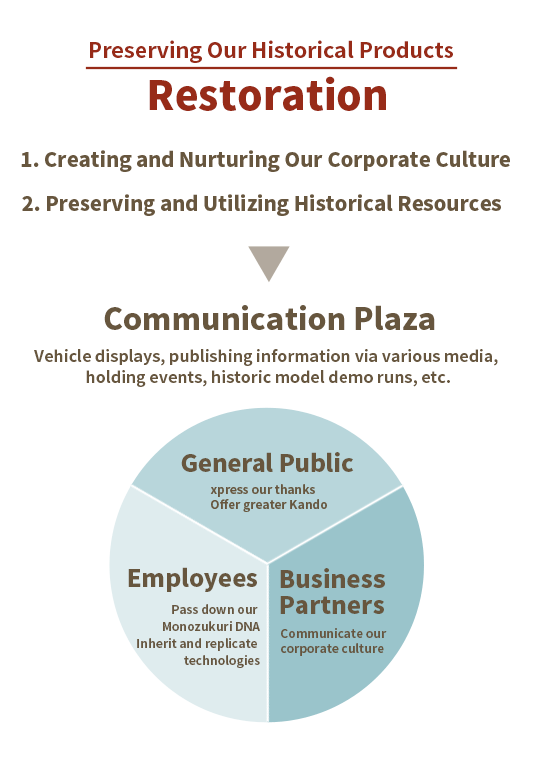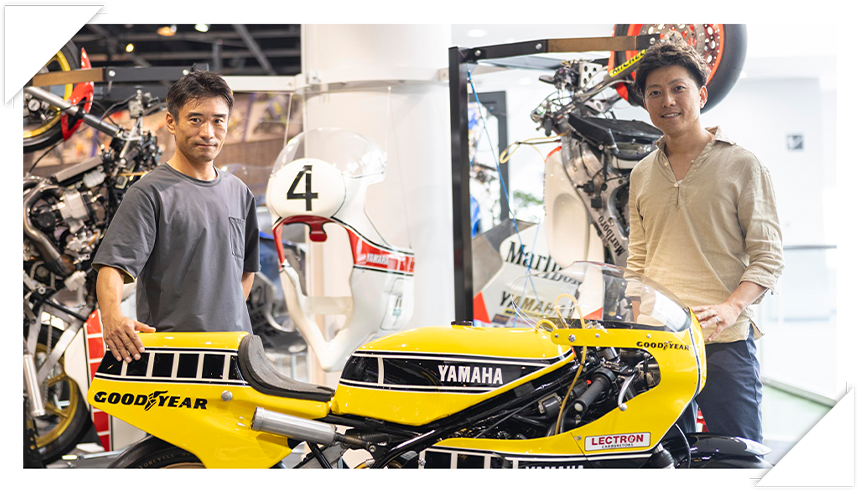This year marks 68 years since Yamaha Motor sold its first motorcycle, the YA-1. Since then, we have gone on to write new stories with countless other models as well as bringing many such stories to conclusion, but we still continue to collect and restore historically significant machines from our past, aiming to keep them all in running condition. The Plaza’s collection of fully restored machines today now exceeds 200 models.
There are two reasons why Yamaha has devoted so much time and effort over the years to finding and restoring its classic machines to running condition.

1. Creating and Nurturing Our Corporate Culture
The historical vehicles that are restored back to the same appearance and performance when they were first manufactured are valuable cultural assets for Yamaha Motor. Being able to get a comprehensive view of how the Unique Style of Yamaha has been passed down through the eras through these models not only helps further permeate our corporate culture but also helps keep that culture alive into the future.
2. Preserving and Utilizing Historical Resources
All restored Yamaha vehicles double as valuable historical resources that help us better understand the development ideals and the state of motorcycling culture of their respective eras, and as such are prized assets. We will continue to treasure them and put them to good use internally and externally.
The historical vehicles on display at the Communication Plaza are changed on a regular basis, and the facility is open for visiting not only by company employees and our business partners but also to the general public like the customers who love our products. It is our hope that our historical machines help grow the circle of communication amongst these three parties.

In addition to the vehicles on display at the Communication Plaza, more than 200 historical vehicles are stored at the Toyooka Technical Center. The ideas and philosophies that Yamaha developers of the past packed into these machines are transcending their respective eras by providing new inspiration for today’s modern Monozukuri. In carrying out the XSR900’s 2022 model update, the project team actively referred to and was inspired by the old racebikes they examined at the Center, and we talked to two designers that helped develop the bike.


Product Design 3 Group, Product Design Division, Creative Center (YMC)
Has handled numerous Yamaha Motor product designs, including the first XSR900 and MT-09. He was also in charge of the design planning for the current XSR900.
A Place Full of Yamaha Brand Stories and History
The neo-retro bike market that the XSR marque is positioned in has experienced a boom that has contributed to competition in the segment becoming fiercer in recent years. As a result, there was a need for us to more clearly communicate the history, values, and messaging within the Yamaha brand with the new XSR900.
So, the project’s designers, engineers, and other members visited the Toyooka Technical Center to view some of the classic motorcycles stored there firsthand, where we were able to sit on a number of historically significant racebikes, including the legendary YZR500. Racebikes are basically the highest form of custom-made machines around since they are built to suit the body shapes and riding styles of their racers, but by actually sitting on them, we realized just how much all of the parts that touch the rider were specifically crafted to foster a better feeling of fit and unity. It was like the shapes of each and every individual part revealed the thoughts and ideas of their developers. I believe that rich spirit of dedication to Monozukuri is what has been handed down over the year at Yamaha, and to be able to not only see but also feel how it took concrete shape all in one place was a truly valuable experience, even for us as Yamaha designers.
We wanted to understand Yamaha Motor’s original approaches to all the technologies that have been passed down and how the qualities that make a motorcycle fun to ride were expressed in these bikes from the past. We were also able to speak about these matters with members of the restoration team and their input was invaluable. I hope that if you see or ride the new XSR900, you feel the stories and history behind the Yamaha brand and gain a newfound appreciation for the efforts of the restorers that work so hard to preserve and pass on those irreplaceable parts of our company heritage.






Product Dynamic Design Division,
GK Dynamics
In addition to the current XSR900 and YZF-R1, he has done 3D design work for numerous other Yamaha motorcycles, LMWs, and ROVs, including the NIKEN and YXZ1000R.
A New Design Approach Established
by Interacting with Historic Motorcycles
Work often takes me to Yamaha Motor and I frequently visit the Communication Plaza when I have a break or in between work and meetings. There are bikes from all different eras, so it’s very interesting just looking at how motorcycle design has evolved over the years, but I also find it very instructive to try changing perspectives and focusing more on things like the shapes of fuel tanks, the different components, and the various details and finishes. Doing this always gives me new findings when I visit. When working on the update for the new XSR900, I also visited the restoration workshop at the Toyooka Technical Center. I’d heard there are many machines there that have not yet been displayed at the Communication Plaza, but I was astonished to see just how many prized bikes are actually stored there.
To get a feel for how Yamaha’s racebikes came to the fore as well as the technical ideas behind them, we all sat on those old racebikes in the order of their respective eras to compare them. The oldest machines are very narrow and the rider sits quite far to the rear, so you realize how cramped it can be once you sit on one. But from the YZR500 onwards, I distinctly felt that these later machines were specifically built around how the rider needs to move on the bike; the positioning of the handlebars and the shape of the tanks were designed so as not to hinder the rider’s movement. On top of accomplishing that, they all left no stone unturned in terms of their completeness as motorcycles and radiated this wonderful aura and presence that once again left me surprised. The incredible rider-centric approach and the priority Jin-Ki Kanno took in their Monozukuri inspired me to incorporate similar philosophies in the design of the new XSR900.
To make sure we did not forget the feelings and sensations we all picked up from sitting on those bikes at Toyooka, the project team quickly returned to our own workshop, and we began carving away at a Styrofoam mockup and sitting on it repeatedly until we were able to replicate the tank shape we envisioned. The usual design process starts with sketches, but with the XSR900, we ended up drawing sketches based on the shape of that first prototype tank. I heard that during development of the YZR500, the engineers drafted their blueprints while viewing the rider sitting on the bike. Even methods from the past like that inspired us and resulted in a new and very interesting approach to design work.


